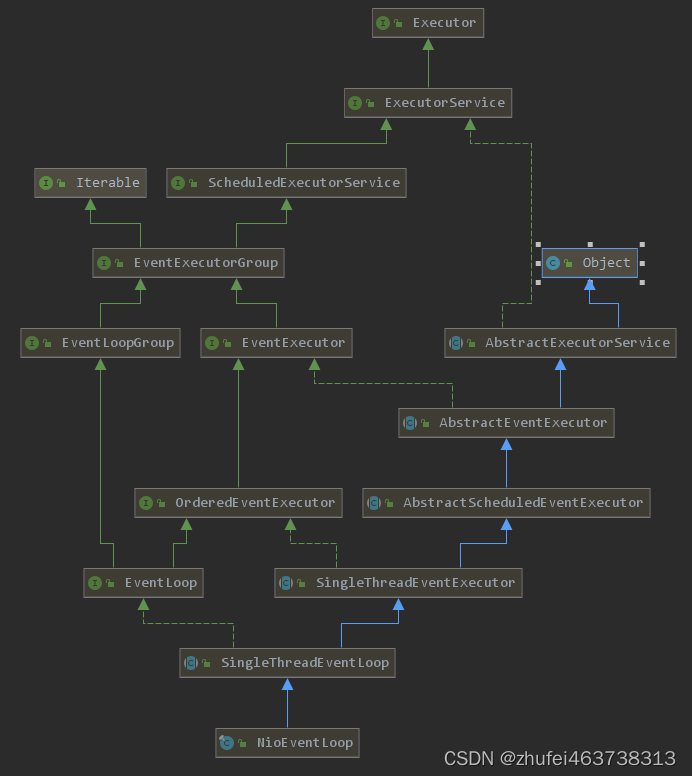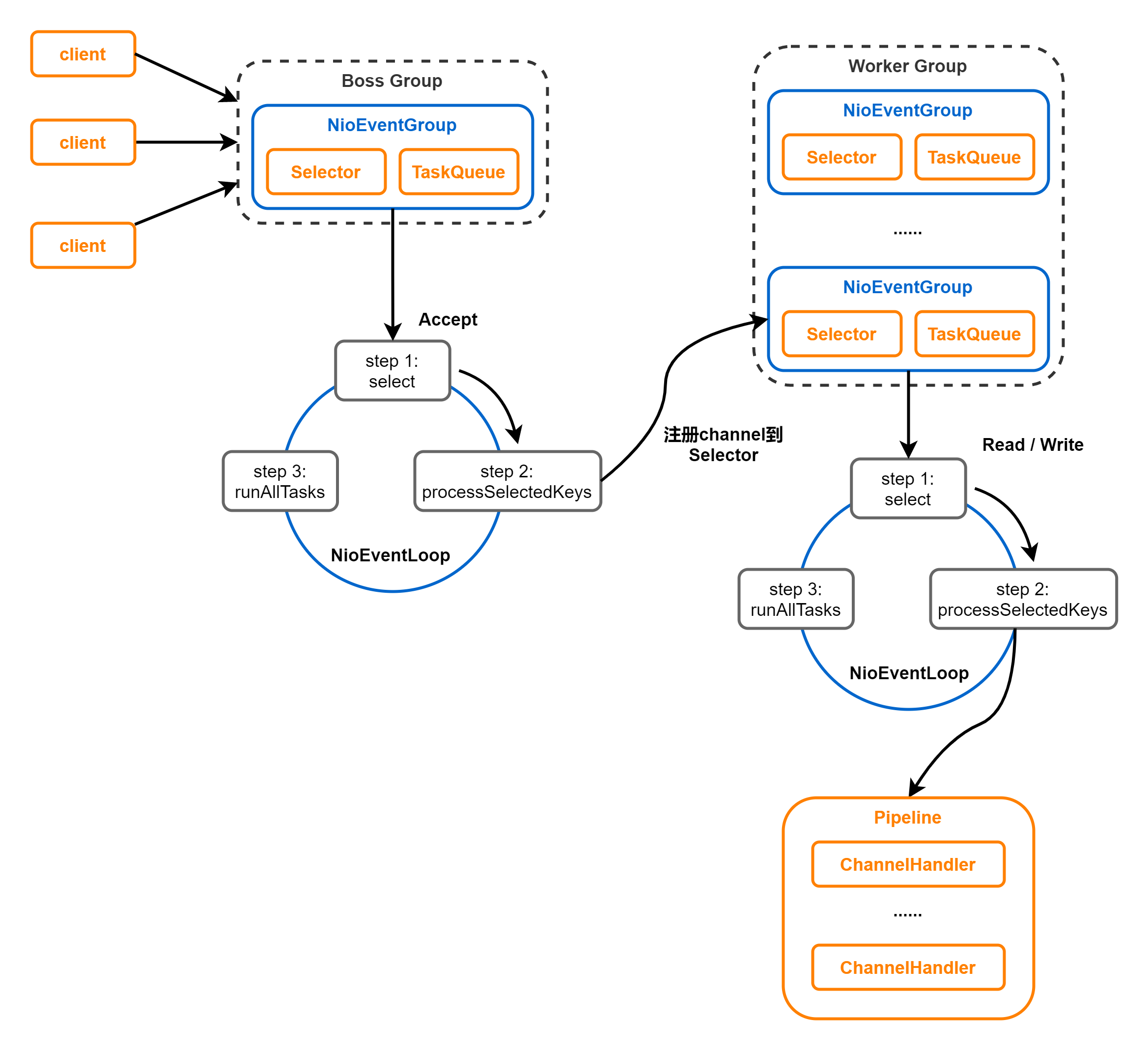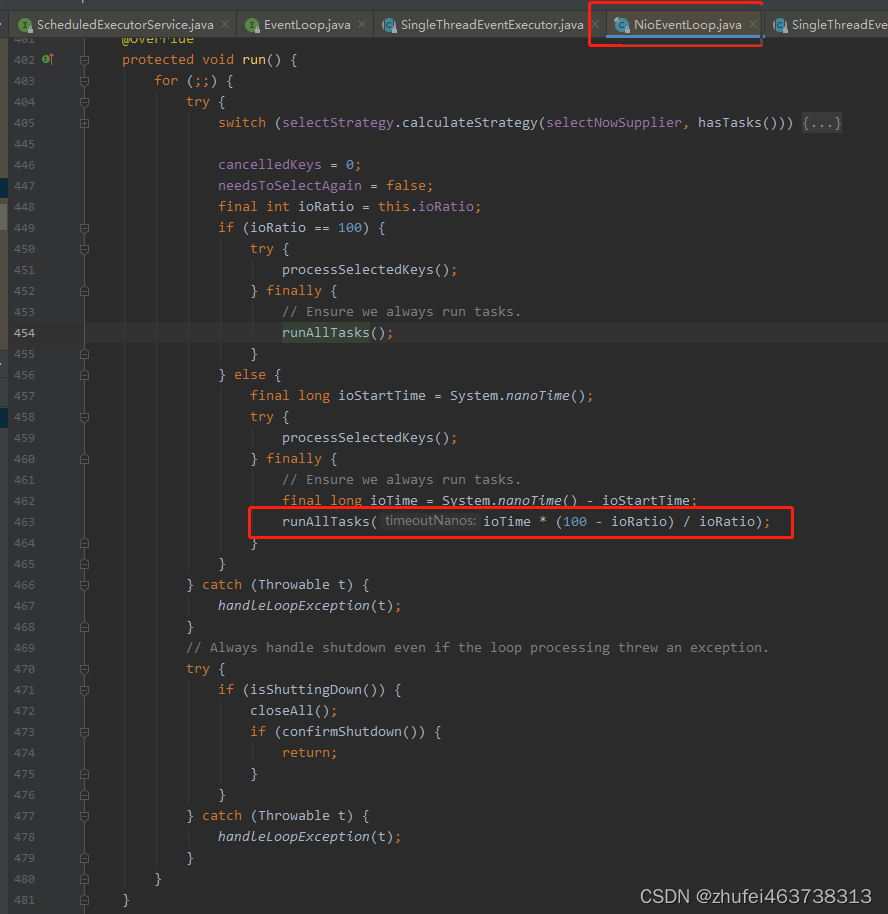25、Netty入门 - EventLoop 源码剖析
1.源码解析目标
分析最核心组件 EventLoop 在 Netty 运行过程中所参与的事情,以及具体实现。
1.1 源码解析
使用netty 包example下 Echo 目录下的案例代码,当我们写一个 NettyServer 时候,第一句话就是 EventLoopGroup bossGroup = new NioEventLoopGroup(1);,我们先来看看 NioEventLoop 的 UML 图。

- 首先我们看 ScheduledEecutorService 接口,这个接口是 concurrent 包下的一个定时任务接口, EventLoop 实现了这个接口,因此可以接受定时任务,所以我们在 dubug 的时候,能在 EventLoop 中找到一个 scheduledTaskQueue。
- EventLoop 接口我们看下源码,如下,从注释中我们了解到,EventLoop 中一旦注册了 Channel,就会处理该 Channel 对应的所有 I/O 操作
/**
* Will handle all the I/O operations for a {@link Channel} once registered.
*
* One {@link EventLoop} instance will usually handle more than one {@link Channel} but this may depend on
* implementation details and internals.
*
*/
public interface EventLoop extends OrderedEventExecutor, EventLoopGroup {
@Override
EventLoopGroup parent();
}
- SingleThreadEventExecutor 也是一个比较重要的类,看源码注释,说明了SingleThreadEventExecutor 是一个单个线程的线程池
/**
* Abstract base class for {@link OrderedEventExecutor}'s that execute all its submitted tasks in a single thread.
*
*/
public abstract class SingleThreadEventExecutor extends AbstractScheduledEventExecutor implements OrderedEventExecutor {......}
- 在SingleThreadEventExecutor 类中实现了很多对线程池的操作,例如runAllTask,executer,takeTask,pollTask,看下其中一个构造方法:
/**
* Create a new instance
*
* @param parent the {@link EventExecutorGroup} which is the parent of this instance and belongs to it
* @param executor the {@link Executor} which will be used for executing
* @param addTaskWakesUp {@code true} if and only if invocation of {@linkaddTask(Runnable)} will wake up the
* executor thread
* @param maxPendingTasks the maximum number of pending tasks before new tasks will be rejected.
* @param rejectedHandler the {@link RejectedExecutionHandler} to use.
*/
protected SingleThreadEventExecutor(EventExecutorGroup parent, Executor executor,
boolean addTaskWakesUp, int maxPendingTasks,
RejectedExecutionHandler rejectedHandler) {
super(parent);
this.addTaskWakesUp = addTaskWakesUp;
this.maxPendingTasks = Math.max(16, maxPendingTasks);
this.executor = ObjectUtil.checkNotNull(executor, "executor");
taskQueue = newTaskQueue(this.maxPendingTasks);
rejectedExecutionHandler = ObjectUtil.checkNotNull(rejectedHandler, "rejectedHandler");
}
/**
* Create a new {@link Queue} which will holds the tasks to execute. This default implementation will return a
* {@link LinkedBlockingQueue} but if your sub-class of {@link SingleThreadEventExecutor} will not do any blocking
* calls on the this {@link Queue} it may make sense to {@code @Override} this and return some more performant
* implementation that does not support blocking operations at all.
*/
protected Queue<Runnable> newTaskQueue(int maxPendingTasks) {
return new LinkedBlockingQueue<Runnable>(maxPendingTasks);
}
- 如上,SingleThreadEventExecutor 队列中元素是实现了 Runnable 接口的对象,线程池中最重要的方法当然是 executer 方法,EventLoop 是 SingleThreadEventExecutor 的子类,那么EventLoop 类也可以直接调用 executer 方法来完成对事件的执行,我们来看源码
@Override
public void execute(Runnable task) {
if (task == null) {
throw new NullPointerException("task");
}
// 判断EventLoop中线程是否是当前线程,如果是,则直接将task添加到线程池队列中
boolean inEventLoop = inEventLoop();
// 如果不是则尝试启动一个线程(因为是单个线程的线程池,所以只能且只需要启动一次),
// 之后在将任务添加到队列中去
if (inEventLoop) {
addTask(task);
} else {
startThread();
addTask(task);
// 如果线程已经停止并且删除任务失败,则直接拒绝策略
if (isShutdown() && removeTask(task)) {
reject();
}
}
if (!addTaskWakesUp && wakesUpForTask(task)) {
wakeup(inEventLoop);
}
}
接着看addTask 的实现
/**
* Add a task to the task queue, or throws a {@link RejectedExecutionException} if this instance was shutdown
* before.
*/
protected void addTask(Runnable task) {
if (task == null) {
throw new NullPointerException("task");
}
if (!offerTask(task)) {
reject(task);
}
}
final boolean offerTask(Runnable task) {
if (isShutdown()) {
reject();
}
return taskQueue.offer(task);
}
- 从注释中可以看出,addTask 方法会添加一个task任务到队列中,如果当前线程是 shutdown 的状态,那么直接抛出异常 RejectedExecutionException
- 接着来看 executer 方法中的 startThread(); ,当我们判断当前线程不是 EventLoop中 的线程的时候会执行这个方法,它是 NioEventLoop 中的核心方法,如下源码
private void startThread() {
// 通过状态判断是否执行过,保证EventLoop只有一个线程
if (state == ST_NOT_STARTED) {
// 如果没有启动 用cas的方式STATE_UPDATER.compareAndSet(this, ST_NOT_STARTED, ST_STARTED) 去修改状态为ST_STARTED,直接调用doStartThread方法
if (STATE_UPDATER.compareAndSet(this, ST_NOT_STARTED, ST_STARTED)) {
try {
doStartThread();
} catch (Throwable cause) {
// 如果失败就回滚
STATE_UPDATER.set(this, ST_NOT_STARTED);
PlatformDependent.throwException(cause);
}
}
}
}
private void doStartThread() {
assert thread == null;
executor.execute(new Runnable() {
@Override
public void run() {
thread = Thread.currentThread();
if (interrupted) {
thread.interrupt();
}
boolean success = false;
updateLastExecutionTime();
try {
SingleThreadEventExecutor.this.run();
success = true;
} catch (Throwable t) {
logger.warn("Unexpected exception from an event executor: ", t);
} finally {
for (;;) {
int oldState = state;
if (oldState >= ST_SHUTTING_DOWN || STATE_UPDATER.compareAndSet(
SingleThreadEventExecutor.this, oldState, ST_SHUTTING_DOWN)) {
break;
}
}
// Check if confirmShutdown() was called at the end of the loop.
if (success && gracefulShutdownStartTime == 0) {
logger.error("Buggy " + EventExecutor.class.getSimpleName() + " implementation; " +
SingleThreadEventExecutor.class.getSimpleName() + ".confirmShutdown() must be called " +
"before run() implementation terminates.");
}
try {
// Run all remaining tasks and shutdown hooks.
for (;;) {
if (confirmShutdown()) {
break;
}
}
} finally {
try {
cleanup();
} finally {
STATE_UPDATER.set(SingleThreadEventExecutor.this, ST_TERMINATED);
threadLock.release();
if (!taskQueue.isEmpty()) {
logger.warn(
"An event executor terminated with " +
"non-empty task queue (" + taskQueue.size() + ')');
}
terminationFuture.setSuccess(null);
}
}
}
}
});
}
-
接着分析 doStartThread 方法,首先会调用 Executor 的 execute 方法,这个 Executor 是我们在创建 EventLoopGroup 时候创建的是一个 ThreadPerTaskExecutor 类,如下图是在 channel 中对应的 EventLoop 找到的对象信息,该 execute 方法会将 Runable 包装成 Netty 的 FastThreadLocalThread
-
接着通过Thread.currentThread() 判断线程是否中断
-
updateLastExecutionTime(); 然后设置最后一次执行的时间
-
核心方法是:SingleThreadEventExecutor.this.run(); 执行当前NioEventLoop的run方法,等会重点关注
-
接着完成run方法的事物处理后,在finally中使用cas不断的修改state状态,设置为ST_SHUTTING_DOWN,也就是当loop中run方法结束运行后,关闭线程,最后还会通过不断轮询来二次确认是否关闭,否则不会break跳出
-
接下来分析EventLoop中的Run方法,我们进入Run方法,就到了我们之前分析过的NioEventLoop中的run方法,此方法做了三件事情,如下源码
@Override
protected void run() {
for (;;) {
try {
switch (selectStrategy.calculateStrategy(selectNowSupplier, hasTasks())) {
case SelectStrategy.CONTINUE:
continue;
case SelectStrategy.SELECT:
select(wakenUp.getAndSet(false));
// 'wakenUp.compareAndSet(false, true)' is always evaluated
// before calling 'selector.wakeup()' to reduce the wake-up
// overhead. (Selector.wakeup() is an expensive operation.)
//
// However, there is a race condition in this approach.
// The race condition is triggered when 'wakenUp' is set to
// true too early.
//
// 'wakenUp' is set to true too early if:
// 1) Selector is waken up between 'wakenUp.set(false)' and
// 'selector.select(...)'. (BAD)
// 2) Selector is waken up between 'selector.select(...)' and
// 'if (wakenUp.get()) { ... }'. (OK)
//
// In the first case, 'wakenUp' is set to true and the
// following 'selector.select(...)' will wake up immediately.
// Until 'wakenUp' is set to false again in the next round,
// 'wakenUp.compareAndSet(false, true)' will fail, and therefore
// any attempt to wake up the Selector will fail, too, causing
// the following 'selector.select(...)' call to block
// unnecessarily.
//
// To fix this problem, we wake up the selector again if wakenUp
// is true immediately after selector.select(...).
// It is inefficient in that it wakes up the selector for both
// the first case (BAD - wake-up required) and the second case
// (OK - no wake-up required).
if (wakenUp.get()) {
selector.wakeup();
}
// fall through
default:
}
cancelledKeys = 0;
needsToSelectAgain = false;
final int ioRatio = this.ioRatio;
if (ioRatio == 100) {
try {
processSelectedKeys();
} finally {
// Ensure we always run tasks.
runAllTasks();
}
} else {
final long ioStartTime = System.nanoTime();
try {
processSelectedKeys();
} finally {
// Ensure we always run tasks.
final long ioTime = System.nanoTime() - ioStartTime;
runAllTasks(ioTime * (100 - ioRatio) / ioRatio);
}
}
} catch (Throwable t) {
handleLoopException(t);
}
// Always handle shutdown even if the loop processing threw an exception.
try {
if (isShuttingDown()) {
closeAll();
if (confirmShutdown()) {
return;
}
}
} catch (Throwable t) {
handleLoopException(t);
}
}
}
-
NioEventLoop 中的 loop 轮询是依靠 run 方法来执行的,在方法中可以看到是一个 for 循环其中三件事情,如下图中EventLoop部分
-
case SelectStrategy.SELECT: 当事件类似是SELECT 时候, 通过select(wakenUp.getAndSet(false));方法获取感兴趣的事件
-
processSelectedKeys(); 处理选中的事件
-
runAllTasks 执行队列中的任务。

- 上图不管是bossGroup还是WorkerGroup中的EventLoop都由run方法完成
select 方法实现
private void select(boolean oldWakenUp) throws IOException {
Selector selector = this.selector;
try {
int selectCnt = 0;
long currentTimeNanos = System.nanoTime();
long selectDeadLineNanos = currentTimeNanos + delayNanos(currentTimeNanos);
for (;;) {
long timeoutMillis = (selectDeadLineNanos - currentTimeNanos + 500000L) / 1000000L;
if (timeoutMillis <= 0) {
if (selectCnt == 0) {
selector.selectNow();
selectCnt = 1;
}
break;
}
// If a task was submitted when wakenUp value was true, the task didn't get a chance to call
// Selector#wakeup. So we need to check task queue again before executing select operation.
// If we don't, the task might be pended until select operation was timed out.
// It might be pended until idle timeout if IdleStateHandler existed in pipeline.
if (hasTasks() && wakenUp.compareAndSet(false, true)) {
selector.selectNow();
selectCnt = 1;
break;
}
int selectedKeys = selector.select(timeoutMillis);
selectCnt ++;
if (selectedKeys != 0 || oldWakenUp || wakenUp.get() || hasTasks() || hasScheduledTasks()) {
// - Selected something,
// - waken up by user, or
// - the task queue has a pending task.
// - a scheduled task is ready for processing
break;
}
if (Thread.interrupted()) {
// Thread was interrupted so reset selected keys and break so we not run into a busy loop.
// As this is most likely a bug in the handler of the user or it's client library we will
// also log it.
//
// See https://github.com/netty/netty/issues/2426
if (logger.isDebugEnabled()) {
logger.debug("Selector.select() returned prematurely because " +
"Thread.currentThread().interrupt() was called. Use " +
"NioEventLoop.shutdownGracefully() to shutdown the NioEventLoop.");
}
selectCnt = 1;
break;
}
long time = System.nanoTime();
if (time - TimeUnit.MILLISECONDS.toNanos(timeoutMillis) >= currentTimeNanos) {
// timeoutMillis elapsed without anything selected.
selectCnt = 1;
} else if (SELECTOR_AUTO_REBUILD_THRESHOLD > 0 &&
selectCnt >= SELECTOR_AUTO_REBUILD_THRESHOLD) {
// The selector returned prematurely many times in a row.
// Rebuild the selector to work around the problem.
logger.warn(
"Selector.select() returned prematurely {} times in a row; rebuilding Selector {}.",
selectCnt, selector);
rebuildSelector();
selector = this.selector;
// Select again to populate selectedKeys.
selector.selectNow();
selectCnt = 1;
break;
}
currentTimeNanos = time;
}
if (selectCnt > MIN_PREMATURE_SELECTOR_RETURNS) {
if (logger.isDebugEnabled()) {
logger.debug("Selector.select() returned prematurely {} times in a row for Selector {}.",
selectCnt - 1, selector);
}
}
} catch (CancelledKeyException e) {
if (logger.isDebugEnabled()) {
logger.debug(CancelledKeyException.class.getSimpleName() + " raised by a Selector {} - JDK bug?",
selector, e);
}
// Harmless exception - log anyway
}
}
-
关注点在于 select方法如何体现出非阻塞,如下图中,选择器获取对应事件debug
-
在select中参数timeoutMillis是1 秒,也就是默认情况下阻塞1秒中,具体的算法: long timeoutMillis = (selectDeadLineNanos - currentTimeNanos + 500000L) / 1000000L;
-
其中 long selectDeadLineNanos = currentTimeNanos + delayNanos(currentTimeNanos); 表示当前时间 + 定时任务的时间,那么timeoutMillis 意思就是,当有定时任务的时候 delayNanos(currentTimeNanos) 返回的事件不为空,那么定时任务剩余时间 t +0.5秒阻塞的时间,否则就默认1秒中阻塞时间
-
接着判断: if (selectedKeys != 0 || oldWakenUp || wakenUp.get() || hasTasks() || hasScheduledTasks())
-
如果1秒(或者t+0.5)后能获取到selectedKeys :selectedKeys != 0
-
或者select被用户唤醒 :oldWakenUp, wakenUp.get()
-
或者任务队列中有任务存在 : hasTasks()
-
或者有定时任务即将被执行 : hasScheduledTasks()
-
有以上任何情况则跳出循环,否则继续轮询,直到满足其中一个条件为止
runAllTask实现
- 在接着runAllTasks 的执行参数

- ioRatio 默认大小50,ioStartTime 记录执行processSelectedKeys之前的事件,ioTime计算processSelectedKeys执行耗时
- ioTime * (100 - ioRatio) / ioRatio。processSelectedKeys * (100 -50)/100,也就是取processSelectedKeys 耗时一半的事件作为runAllTask的入参
- 进入runAllTask
/**
* Poll all tasks from the task queue and run them via {@link Runnable#run()} method. This method stops running
* the tasks in the task queue and returns if it ran longer than {@code timeoutNanos}.
*/
protected boolean runAllTasks(long timeoutNanos) {
fetchFromScheduledTaskQueue();
Runnable task = pollTask();
if (task == null) {
afterRunningAllTasks();
return false;
}
final long deadline = ScheduledFutureTask.nanoTime() + timeoutNanos;
long runTasks = 0;
long lastExecutionTime;
for (;;) {
safeExecute(task);
runTasks ++;
// Check timeout every 64 tasks because nanoTime() is relatively expensive.
// XXX: Hard-coded value - will make it configurable if it is really a problem.
if ((runTasks & 0x3F) == 0) {
lastExecutionTime = ScheduledFutureTask.nanoTime();
if (lastExecutionTime >= deadline) {
break;
}
}
task = pollTask();
if (task == null) {
lastExecutionTime = ScheduledFutureTask.nanoTime();
break;
}
}
afterRunningAllTasks();
this.lastExecutionTime = lastExecutionTime;
return true;
}
- fetchFromScheduledTaskQueue首先获取一个即将要执行的定时任务task,并将此任务添加到任务队列taskQueue中
- deadline = ScheduledFutureTask.nanoTime() + timeoutNanos;根据之前计算事件的出本次轮询任务执行的最后时间
- for循环中,执行任务队列中任务,每次执行完统计时间,当任务队列中task 空,或者时间超过了deadline,则跳出,完成本次执行轮询,更新任务的最后执行时间
- 总结runAllTask,就是在规定时间内,尽量多的执行queue或者scheduler中的任务
processSelectedKeys 实现
- processSelectedKeys 的作用是处理事件,例如,连接,接收连接,读,写事件,接下来看源码
private void processSelectedKeys() {
if (selectedKeys != null) {
processSelectedKeysOptimized();
} else {
processSelectedKeysPlain(selector.selectedKeys());
}
}
- 当selectedKeys不为空,说明有事件需要处理,processSelectedKeysOptimized 是具体处理的逻辑,最终的实现代码如下
private void processSelectedKey(SelectionKey k, AbstractNioChannel ch) {
final AbstractNioChannel.NioUnsafe unsafe = ch.unsafe();
if (!k.isValid()) {
final EventLoop eventLoop;
try {
eventLoop = ch.eventLoop();
} catch (Throwable ignored) {
// If the channel implementation throws an exception because there is no event loop, we ignore this
// because we are only trying to determine if ch is registered to this event loop and thus has authority
// to close ch.
return;
}
// Only close ch if ch is still registered to this EventLoop. ch could have deregistered from the event loop
// and thus the SelectionKey could be cancelled as part of the deregistration process, but the channel is
// still healthy and should not be closed.
// See https://github.com/netty/netty/issues/5125
if (eventLoop != this || eventLoop == null) {
return;
}
// close the channel if the key is not valid anymore
unsafe.close(unsafe.voidPromise());
return;
}
try {
int readyOps = k.readyOps();
// We first need to call finishConnect() before try to trigger a read(...) or write(...) as otherwise
// the NIO JDK channel implementation may throw a NotYetConnectedException.
if ((readyOps & SelectionKey.OP_CONNECT) != 0) {
// remove OP_CONNECT as otherwise Selector.select(..) will always return without blocking
// See https://github.com/netty/netty/issues/924
int ops = k.interestOps();
ops &= ~SelectionKey.OP_CONNECT;
k.interestOps(ops);
unsafe.finishConnect();
}
// Process OP_WRITE first as we may be able to write some queued buffers and so free memory.
if ((readyOps & SelectionKey.OP_WRITE) != 0) {
// Call forceFlush which will also take care of clear the OP_WRITE once there is nothing left to write
ch.unsafe().forceFlush();
}
// Also check for readOps of 0 to workaround possible JDK bug which may otherwise lead
// to a spin loop
if ((readyOps & (SelectionKey.OP_READ | SelectionKey.OP_ACCEPT)) != 0 || readyOps == 0) {
unsafe.read();
}
} catch (CancelledKeyException ignored) {
unsafe.close(unsafe.voidPromise());
}
}
- k.isValid() 首先判断SelectionKey 是否合法
- readyOps = k.readyOps(); 获取事件类型
- OP_CONNECT 事件处理逻辑:当获取到连接事件,在NIO中我们需要确定是否已经完成连接,会调用unsafe.finishConnect(); 方法,底层是利用Nio中的SocketChannel.finishConnect 完成连接操作
- OP_WRITE 事件处理逻辑:直接调用forceFlush,完成缓存刷新,此处有必要解释一下,根源码,最终来到flush0 方法,如下
@Override
protected final void flush0() {
// Flush immediately only when there's no pending flush.
// If there's a pending flush operation, event loop will call forceFlush() later,
// and thus there's no need to call it now.
if (isFlushPending()) {
return;
}
super.flush0();
}
- 在实际flush之前,netty调用isFlushPending判断,这个channel是否注册了可写事件,如果有可写事件就等会再发送。如果没有,就会调用父类的flush0方法直接写。解释之前我们先要了解ChannelOutboundBuffer
- 每个 ChannelSocket 的 Unsafe 都有一个绑定的 ChannelOutboundBuffer , Netty 向站外输出数据的过程统一通过 ChannelOutboundBuffer 类进行封装,目的是为了提高网络的吞吐量,在外面调用 write 的时候,数据并没有写到 Socket,而是写到了 ChannelOutboundBuffer 这里,当调用 flush 的时候,才真正的向 Socket 写出,而write只是将数据写入ChanneloutboundBuffer这个单向链表中
- 之后我们重新开一篇文来说明ChannelOutboundBuffer在写事件中的具体实现以及Netty(nio)对写事件效率提升的一些优化
- 接着回到processSelectedKey ,之后会处理OP_READ,OP_ACCEPT 事件,会调用NioMessageUnsafe 的read方法对传入的数据进行读操作
1.2 总结
- 每次执行execute方法就会向队列中添加任务。当第一次添加时候就启动线程,执行run方法,run方法是EventLoop的核心实现,负责轮询获取事件,处理事件,执行队列中任务
- 其中调用selector的select方法默认阻塞一秒,有定时任务就t+0.5,t是定时任务剩余时间,当执行execute方法时候,也就是添加任务的时候,唤醒selector,防止selector阻塞时间过长
- 当selector返回的时候,会调用processSelectedKeys对selectKey进行处理
- 当processSelectedKeys 方法执行结束,按照ioRatio比例执行runAllTasks方法默认是 IO 任务时间和非 IO 任务时间是相同的代码如下